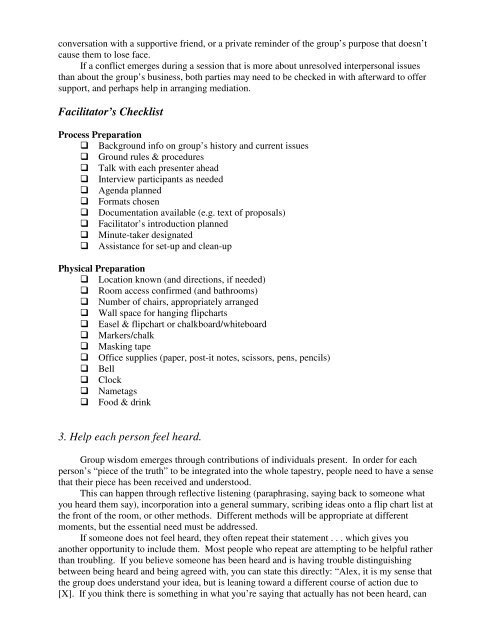GROUP FACILITATION PRIMER.pdf - Tree Bressen
GROUP FACILITATION PRIMER.pdf - Tree Bressen
GROUP FACILITATION PRIMER.pdf - Tree Bressen
Create successful ePaper yourself
Turn your PDF publications into a flip-book with our unique Google optimized e-Paper software.
conversation with a supportive friend, or a private reminder of the group’s purpose that doesn’t<br />
cause them to lose face.<br />
If a conflict emerges during a session that is more about unresolved interpersonal issues<br />
than about the group’s business, both parties may need to be checked in with afterward to offer<br />
support, and perhaps help in arranging mediation.<br />
Facilitator’s Checklist<br />
Process Preparation<br />
� Background info on group’s history and current issues<br />
� Ground rules & procedures<br />
� Talk with each presenter ahead<br />
� Interview participants as needed<br />
� Agenda planned<br />
� Formats chosen<br />
� Documentation available (e.g. text of proposals)<br />
� Facilitator’s introduction planned<br />
� Minute-taker designated<br />
� Assistance for set-up and clean-up<br />
Physical Preparation<br />
� Location known (and directions, if needed)<br />
� Room access confirmed (and bathrooms)<br />
� Number of chairs, appropriately arranged<br />
� Wall space for hanging flipcharts<br />
� Easel & flipchart or chalkboard/whiteboard<br />
� Markers/chalk<br />
� Masking tape<br />
� Office supplies (paper, post-it notes, scissors, pens, pencils)<br />
� Bell<br />
� Clock<br />
� Nametags<br />
� Food & drink<br />
3. Help each person feel heard.<br />
Group wisdom emerges through contributions of individuals present. In order for each<br />
person’s “piece of the truth” to be integrated into the whole tapestry, people need to have a sense<br />
that their piece has been received and understood.<br />
This can happen through reflective listening (paraphrasing, saying back to someone what<br />
you heard them say), incorporation into a general summary, scribing ideas onto a flip chart list at<br />
the front of the room, or other methods. Different methods will be appropriate at different<br />
moments, but the essential need must be addressed.<br />
If someone does not feel heard, they often repeat their statement . . . which gives you<br />
another opportunity to include them. Most people who repeat are attempting to be helpful rather<br />
than troubling. If you believe someone has been heard and is having trouble distinguishing<br />
between being heard and being agreed with, you can state this directly: “Alex, it is my sense that<br />
the group does understand your idea, but is leaning toward a different course of action due to<br />
[X]. If you think there is something in what you’re saying that actually has not been heard, can


